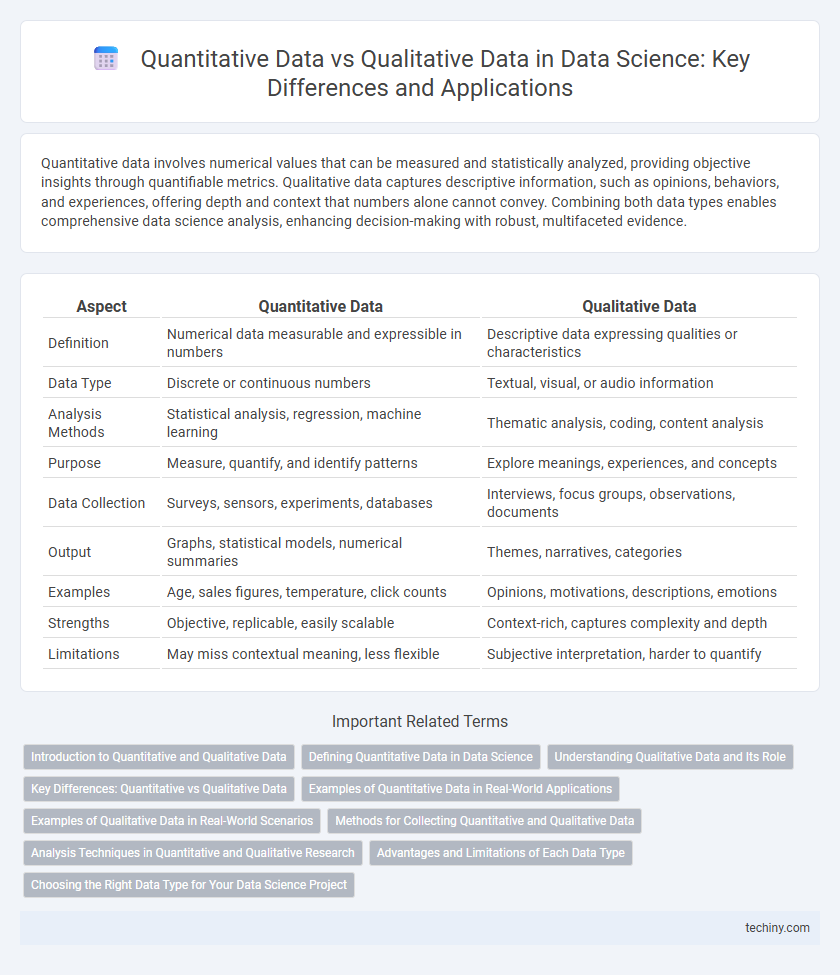Quantitative data involves numerical values that can be measured and statistically analyzed, providing objective insights through quantifiable metrics. Qualitative data captures descriptive information, such as opinions, behaviors, and experiences, offering depth and context that numbers alone cannot convey. Combining both data types enables comprehensive data science analysis, enhancing decision-making with robust, multifaceted evidence.
Table of Comparison
| Aspect | Quantitative Data | Qualitative Data |
|---|---|---|
| Definition | Numerical data measurable and expressible in numbers | Descriptive data expressing qualities or characteristics |
| Data Type | Discrete or continuous numbers | Textual, visual, or audio information |
| Analysis Methods | Statistical analysis, regression, machine learning | Thematic analysis, coding, content analysis |
| Purpose | Measure, quantify, and identify patterns | Explore meanings, experiences, and concepts |
| Data Collection | Surveys, sensors, experiments, databases | Interviews, focus groups, observations, documents |
| Output | Graphs, statistical models, numerical summaries | Themes, narratives, categories |
| Examples | Age, sales figures, temperature, click counts | Opinions, motivations, descriptions, emotions |
| Strengths | Objective, replicable, easily scalable | Context-rich, captures complexity and depth |
| Limitations | May miss contextual meaning, less flexible | Subjective interpretation, harder to quantify |
Introduction to Quantitative and Qualitative Data
Quantitative data consists of numerical values that can be measured and analyzed statistically, such as sales figures, temperature readings, or test scores, enabling objective and precise comparisons. Qualitative data captures descriptive information like opinions, experiences, and behaviors, often collected through interviews, observations, or open-ended surveys, providing depth and context to research findings. Understanding the differences between these data types is essential for selecting appropriate data collection methods and analytical techniques in data science projects.
Defining Quantitative Data in Data Science
Quantitative data in data science refers to numerical information that can be measured and expressed using numbers, enabling statistical analysis and mathematical computations. This type of data includes variables such as age, temperature, sales figures, and test scores, which allow for precise quantification and comparison. Quantitative data supports data-driven decision-making by facilitating predictions, trends identification, and performance evaluations.
Understanding Qualitative Data and Its Role
Qualitative data provides rich, descriptive insights that capture human experiences, behaviors, and social contexts, essential for understanding underlying motivations and patterns in data science. It often consists of non-numeric information such as interviews, observations, and open-ended survey responses, which are analyzed through coding, thematic analysis, and narrative techniques. This data type complements quantitative data by offering depth and context, enabling more nuanced decision-making and hypothesis generation in data-driven projects.
Key Differences: Quantitative vs Qualitative Data
Quantitative data consists of numerical values that can be measured and analyzed statistically, providing insights through metrics such as mean, median, and standard deviation. Qualitative data captures descriptive information through interviews, observations, or open-ended surveys, enabling deeper understanding of patterns, themes, and behaviors. Key differences include the nature of data (numerical vs. descriptive), methods of analysis (statistical vs. thematic), and applications where quantitative data is ideal for hypothesis testing while qualitative data excels in exploratory research.
Examples of Quantitative Data in Real-World Applications
Quantitative data includes measurable, numerical values such as sales revenue, temperature readings, or customer age, enabling precise statistical analysis. In healthcare, quantitative data like blood pressure levels or patient heart rates are critical for monitoring and diagnosis. In marketing, the number of website clicks and conversion rates help businesses optimize strategies based on solid metrics.
Examples of Qualitative Data in Real-World Scenarios
Examples of qualitative data in real-world scenarios include customer feedback expressing satisfaction levels, interview transcripts capturing personal experiences, and social media posts reflecting public opinions. In healthcare, patient descriptions of symptoms and emotions provide valuable insights beyond numerical measurements. These non-numeric data types are crucial for understanding context, motivations, and behaviors in data science analysis.
Methods for Collecting Quantitative and Qualitative Data
Quantitative data collection methods include surveys with structured questionnaires, experiments with controlled variables, and sensor or log data capturing measurable metrics. Qualitative data is gathered through interviews, focus groups, and participant observations that provide in-depth insights into behaviors and motivations. Employing mixed-method approaches enhances data validity by combining numerical trends with contextual understanding.
Analysis Techniques in Quantitative and Qualitative Research
Quantitative research employs statistical analysis techniques such as regression, factor analysis, and hypothesis testing to interpret numerical data and identify patterns. Qualitative research relies on thematic analysis, content analysis, and grounded theory to explore textual or visual data, emphasizing meaning and context. Both approaches utilize specialized software like SPSS for quantitative and NVivo for qualitative analysis to enhance data interpretation accuracy.
Advantages and Limitations of Each Data Type
Quantitative data offers precise measurement and statistical analysis capabilities, enabling clear identification of trends and patterns through numerical values. However, it may overlook contextual details and the complexity of human behavior that qualitative data captures through descriptive insights and narrative depth. Qualitative data enriches understanding by exploring motivations and experiences but faces challenges in standardization and generalizability due to its subjective nature.
Choosing the Right Data Type for Your Data Science Project
Selecting the appropriate data type is crucial for effective data science project outcomes, as quantitative data offers numerical insights ideal for statistical analysis and predictive modeling. Qualitative data provides rich, contextual understanding through text, images, or videos, enabling sentiment analysis and theme extraction. Accurate alignment of data type with project goals enhances model accuracy, interpretability, and decision-making processes.
quantitative data vs qualitative data Infographic

 techiny.com
techiny.com